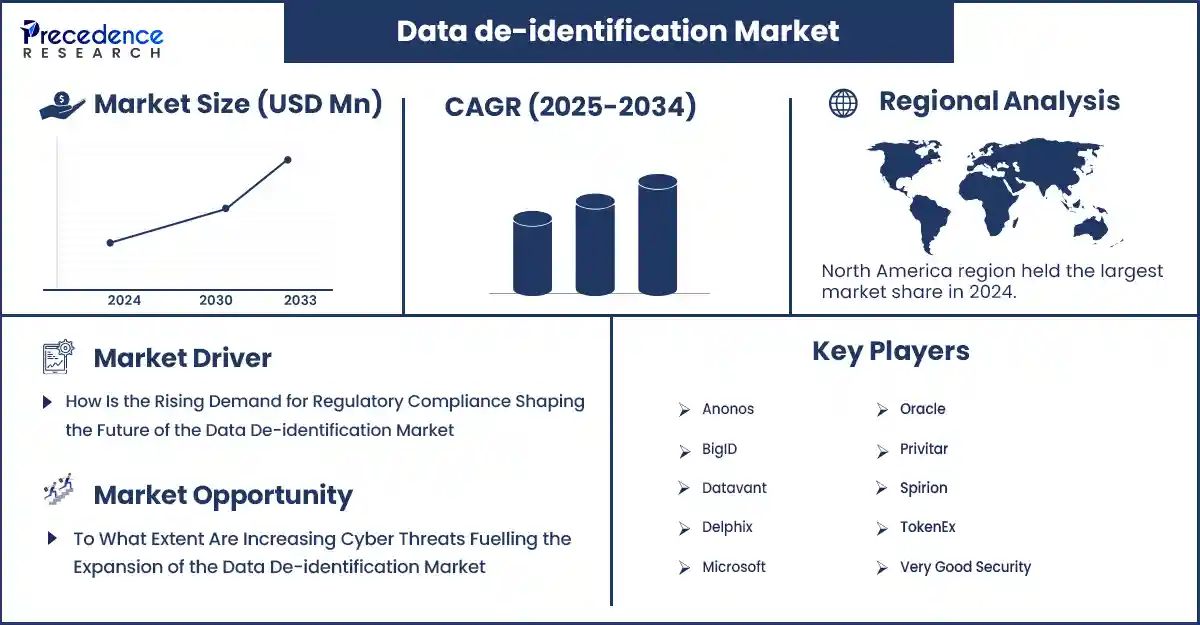Data de-identification Market Revenue and Forecast by 2033
Data de-identification Market Revenue and Trends 2025 to 2033
The global data de-identification market is set for strong growth, driven by stricter privacy laws, rising data breach threats, and adoption across healthcare, finance, and tech. The growth of the market is driven by the increasing demand for data privacy and compliance across various sectors.

Data de-identification Market: Key Drivers & Emerging Opportunities
Data de-identification is a technique used to protect individual privacy by removing or modifying identifying information within datasets. Several important factors are driving the expansion of this market. Foremost among these are increasingly strict data privacy regulations, such as GDPR and HIPAA, which mandate protective measures to ensure compliance and avoid severe penalties. The growing need for secure data sharing and collaboration, particularly in clinical research and public health, also fuels market demand by enabling organizations to pool insights safely. Furthermore, the ongoing rise of big data analytics, cloud computing, and AI technologies necessitates managing privacy risks inherent in processing large, sensitive datasets with technological innovations in automation.
Segment Insights
- By solution type, the data masking segment accounted for the market dominance primarily because it provides a crucial balance between data privacy and data utility without exposing real personal information.
- By deployment model, the on-premises segment led the market due to stringent regulatory compliance requirements, the need for absolute control over sensitive data, and significant existing infrastructure investments by large organizations.
- By data type supported, the structured data segment dominated the data de-identification market primarily because of its ease of processing, analysis, and management using established tools.
- By use case/application, the test data management (TDM) & Analytics segment represented m, market dominance due to the critical need for high-quality, realistic, yet secure data to perform rigorous software testing and ensure regulatory compliance in SDLC.
- By industry vertical, the BFSI and healthcare sectors dominated the market primarily due to the highly sensitive nature of the data they handle and the existence of stringent data privacy regulations that mandate its protection.
- By methodology/technique, the deterministic mapping/pseudonymization segment represented market dominance due to its ability to strike a crucial balance between preserving data utility for analytics and meeting regulatory compliance requirements.
- By integration point, the database/ETL layer segment dominated the market primarily because it provides the foundational, centralized point where raw, sensitive data is ingested, cleansed, and prepared for use in downstream analytics and storage.
- By delivery/service model, the product + professional services mix segment dominated the market because the inherent complexity, risk, and regulatory requirements of data privacy necessitate a combined approach that off-the-shelf software alone cannot satisfy.
- By end user/buyer, the large enterprises segment led the data de-identification market primarily due to their substantial data volumes, complex regulatory environments, and significant financial resources.
Regional Insights
North America dominated the data de-identification market, stemming from its robust regulatory landscape, notably driven by HIPAA and CCPA/CPRA, necessitating strict privacy measures, alongside its advanced technological infrastructure supporting innovations in de-identification solutions. Also, substantial investments in big data analytics across key sectors and companies like IBM and SAS invest in AI-driven algorithms and privacy-preserving technologies such as differential privacy and federated learning to meet evolving needs.
Asia-Pacific region is anticipated to be the fastest-growing in the market, due to an exceptional convergence of rapid digitalization and a swiftly evolving, stricter regulatory landscape. The region has experienced a significant boom in internet and smartphone penetration, the rise of e-commerce, and the widespread adoption of transformative technologies like cloud computing, AI, and big data analytics. This digital acceleration generates immense volumes of personal data, creating a critical need for solutions.
Data de-identification Market Coverage
| Report Attribute | Key Statistics |
| Quantitative Units | Revenue in USD million/billion, Volume in units |
| Largest Market | North America |
| Base Year | 2024 |
| Regions Covered | North America, Europe, Asia-Pacific, Latin America, and the Middle East & Africa |
Recent Development
- In January 2025, Selfii launched TripleBlind Exchange, a first-of-its-kind data marketplace enabling secure, HIPAA/GDPR-compliant access to protected health information without the need for traditional de-identification methods, marking the solution as a novel alternative to current market offerings that meet the de-identification requirements outlined in the HIPAA Privacy Rule and state-level consumer data protection acts.
(Source: https://www.businesswire.com)
Get this report to explore global market size, share, CAGR, and trends, featuring detailed segmental analysis and an insightful competitive landscape overview @ https://www.precedenceresearch.com/sample/6988)
You can place an order or ask any questions, please feel free to contact us at sales@precedenceresearch.com |+1 804 441 9344